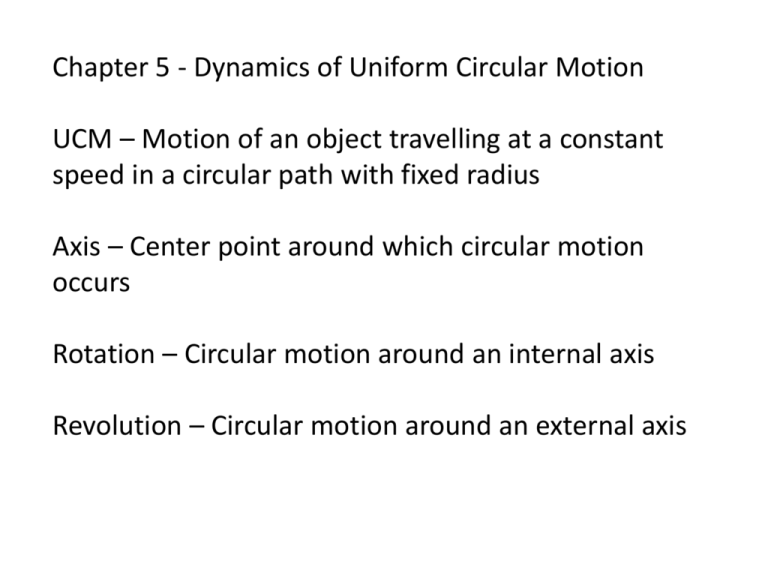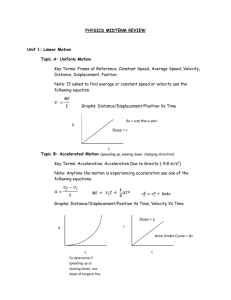Final Notes Chapter 5-8
advertisement

Chapter 5 - Dynamics of Uniform Circular Motion UCM – Motion of an object travelling at a constant speed in a circular path with fixed radius Axis – Center point around which circular motion occurs Rotation – Circular motion around an internal axis Revolution – Circular motion around an external axis Period – T – Time it takes to make one complete oscillation. SI Unit – seconds What is the period of a car’s engine when the tachometer reads 2000.rpms? Circumference – Distance around the outside of a circle C = 2pr Or C = pd The “speed” we are actually talking about is called; Tangential velocity – vt – The velocity of an object tangent to its circular path. Does it depend on radius, if so, why? Absolutely: Radius changes the size of the circle that an object travels in. For an object to cover a certain distance in a specific time, it must travel at a certain speed. For an object in UCM the magnitude of tangential velocity is constant but its direction is constantly changing. If velocity (in this case the direction of it) is changing, what is occurring? Centripetal acceleration – ac – acceleration towards a circle’s center (the word centripetal means moving towards the center, but why the center?) ac = vt2/r Centripetal acceleration = velocity2/radius If there is an acceleration occurring, what also must be present? Centripetal force – Fc – force that causes centripetal acceleration. It isn’t a new force, just a force cause by something pulling inward, such as friction, weight, or tension. Fc = m ac Chapter 6 – Work and Energy Work – done when a force, F, creates a displacement, s. If force and displacement are in the same direction, W=Fs SI Force Distance Work CGS Newton Dyne (N) Meter (m) Centimeter (cm) N*m Dyne*cm Joule (J) erg BE Pound (lb) Foot (ft) ft*lb If force and displacement are not in the same direction, we need to incorporate an angle. Where q is the angle that exists between the force and displacement. W=Fcosqs Kinetic Energy – KE – Energy of motion KE = ½(m)(v2) SI Unit - Joule Work - Energy Theorem When work is done on something, its kinetic energy changes. F=ma F(s) = ma(s) F(s) = m ((v-vo)/(t)) ((½)(v+vo)(t)) F(s) = m (½) ((v-vo)(v+vo)) F(s) = ½ (m) (v2-vo2) F(s) = ½mv2- ½mvo2 W = ½mv2- ½mvo2 W = KE – KEo W = DKE Gravitational Potential Energy – PE – Energy of position (energy based on a position above a reference level) PE = (m)(g)(h) SI – Joule PE is related to the work done by gravity. Wg = -DPE Wg = -(PE-PEo) Conservative Force – A force that does no net work if there is no displacement, i.e. gravity. Non-Conservative Force – A force that does work independent of the path, e.g. friction, air resistance. Wtotal = WNonconsv + Wconsv DKE = WNC + Wg DKE = WNC - DPE WNC = DKE + DPE Conservation of Mechanical Energy If there is no non-conservative work done, Mechanical Energy is conserved. (used for finding final or initial heights or speeds) Eo = E KEo+ PEo = KE + PE ½m(vo2) + mgho = ½m(v2) + mgh ½(vo2) + gho = ½(v2) + gh Non-Conservative Forces and Mechanical Energy WNC = DKE + DPE WNC = (KE – KEo)+ (PE – PEo) WNC = (½m(v2) - ½m(vo2)) + (mgh - mgho) Power – Work done per unit time (or the average rate at which work is done) P = Work/time = W/t SI Unit – Joule/second = Watt CGS – erg/second BE – ft*lb/second Power can also be measured in horsepower 1 h.p. = 550ft*lbs/second = 745.7 Watts Chapter 7: Linear Momentum and Impulse Linear Momentum: p – product of mass and velocity, like inertia it is a resistance to change except it incorporates velocity. p = mv SI Unit – kgm/s How do we change momentum? Impulse – J – product of force and time J = Ft SI Unit – Ns Impulse-Momentum Theorem J = Dp Ft = p – po Ft = mv – mvo Conservation of Linear Momentum The linear momentum of an isolated system remains constant, po = p *Isolated means that no net external forces are present. **A system is two or more things interacting. For an isolated system po = p po1 + po2 = p1 + p2 m1vo1 + m2vo2 = m1v1 + m2v2 Collisions in 2D In one dimension, we can say that po = p In two dimensions, it holds true that pox = px poy = py In other words, the components of the vector are conserved! Chapter 8 Rotational Kinematics Angular Displacement – q - angle through which an object rotates. We denote counter clockwise motion as positive and clockwise motion as negative. SI unit – radian q (measured in radians) = Arc Length/Radius or q = s/r Converting from degrees to radians: 360o = 2p radians or 180o = p radians Angular Velocity – w – rate of angular displacement. w = Dq/t SI Unit – rad/s Does angular speed depend on radius? Angular Acceleration – a – rate of angular velocity changes. a = Dw/t SI Unit – rad/s2 Kinematic Equations Linear v = vo + at s=vt s = vot + ½at2 v2 = vo2 + 2as Rotational w = wo + at q=wt q = wot + ½at2 w2 = wo2 + 2aq Tangential Velocity – vt – the speed and direction of an object moving in a circle. The direction is always tangent to the circle. Ch 5 vt = 2pr/T Ch 8 vt = rw Centripetal Acceleration – ac – acceleration towards a circle’s center. Ch 5 ac = vt2/r Ch 8 ac = rw2 Tangential Acceleration – at – if tangential speed changes, an acceleration is occurring. Ch 5 NONE Ch 8 at = ra Total Acceleration – a – vector sum of centripetal and tangential acceleration. a2 = ac2 + at2 Rolling Motion When a wheel in contact with the ground rotates once, without slipping, it will travel a distance equal to the circumference of its outside edge.



